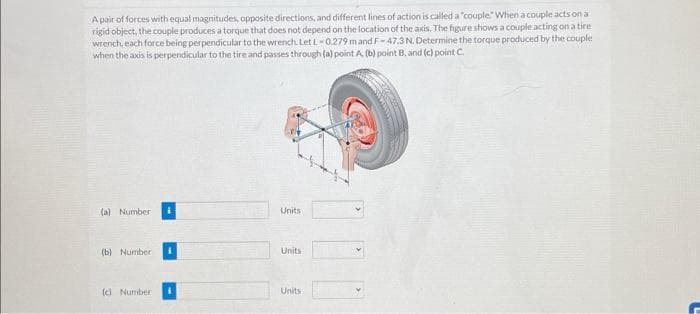A pair of forces with equal magnitudes, opposite directions, and different lines of action is called a "couple" When a couple acts on a rigid object, the couple produces a torque that does not depend on the location of the axis. The figure shows a couple acting on a tire wrench, each force being perpendicular to the wrench Let L -0.279 m and F-47.3 N. Determine the torque produced by the couple when the axis is perpendicular to the tire and passes through (a) point A. (b) point B, and (c) point C. (a) Number (b) Number (c) Number Units Units Units
A pair of forces with equal magnitudes, opposite directions, and different lines of action is called a "couple" When a couple acts on a rigid object, the couple produces a torque that does not depend on the location of the axis. The figure shows a couple acting on a tire wrench, each force being perpendicular to the wrench Let L -0.279 m and F-47.3 N. Determine the torque produced by the couple when the axis is perpendicular to the tire and passes through (a) point A. (b) point B, and (c) point C. (a) Number (b) Number (c) Number Units Units Units
Related questions
Question
Needs Complete typed solution with 100 % accuracy.

Transcribed Image Text:A pair of forces with equal magnitudes, opposite directions, and different lines of action is called a "couple" When a couple acts on a
rigid object, the couple produces a torque that does not depend on the location of the axis. The figure shows a couple acting on a tire
wrench, each force being perpendicular to the wrench Let L-0.279 m and F-47.3 N. Determine the torque produced by the couple
when the axis is perpendicular to the tire and passes through (a) point A, (b) point B, and (c) point C.
(a) Number
(b) Number
(c) Number
Units
Units
Units
Expert Solution
This question has been solved!
Explore an expertly crafted, step-by-step solution for a thorough understanding of key concepts.
This is a popular solution!
Trending now
This is a popular solution!
Step by step
Solved in 3 steps
